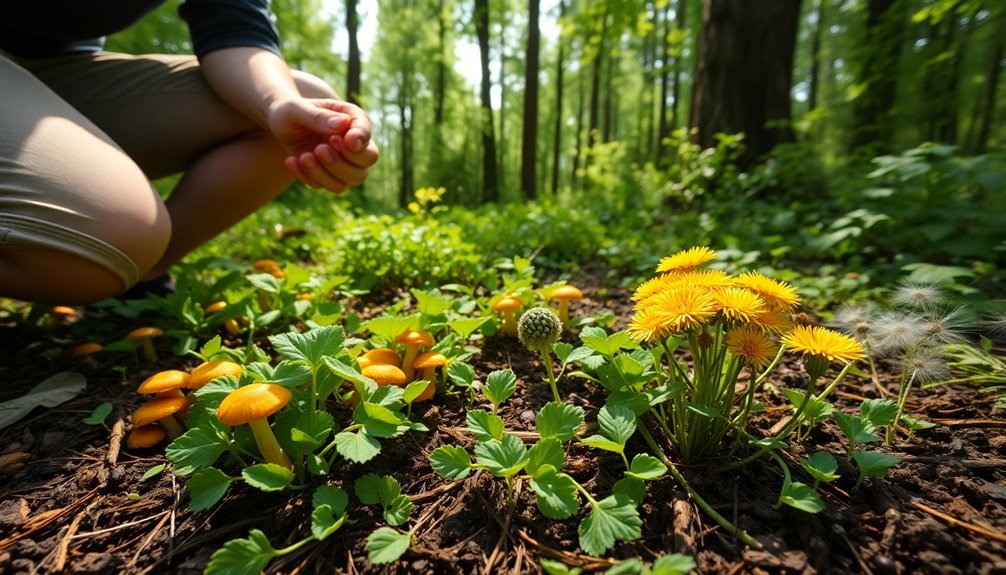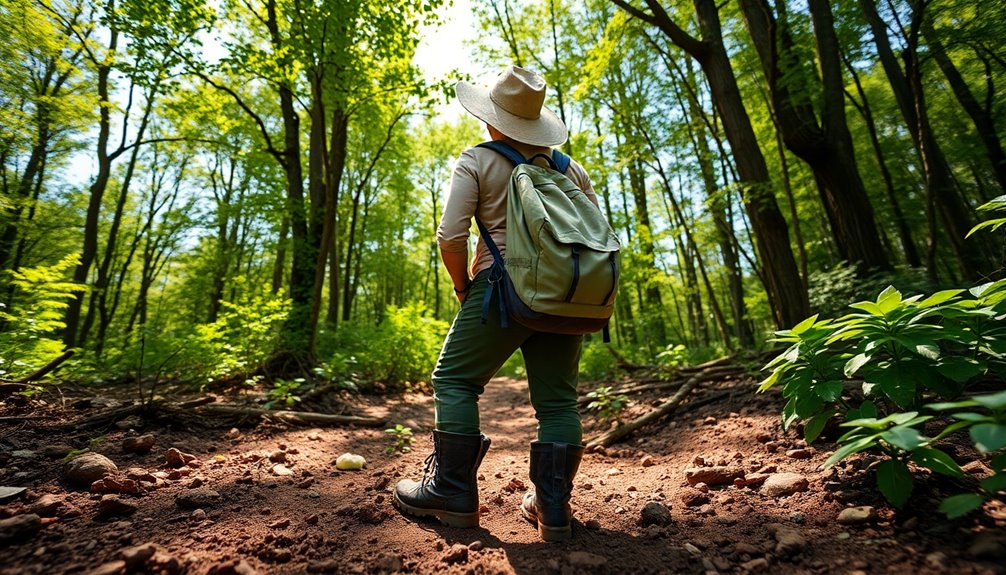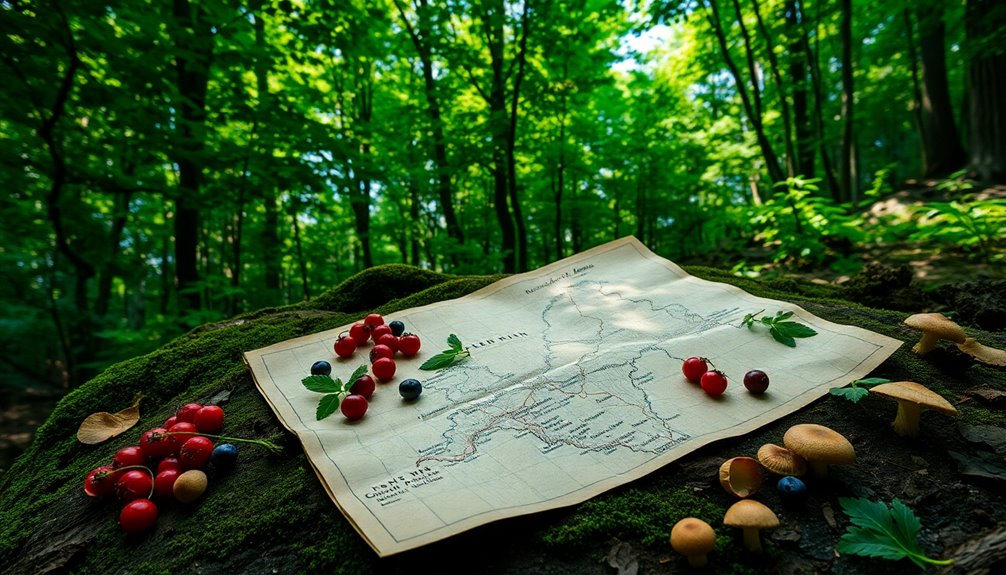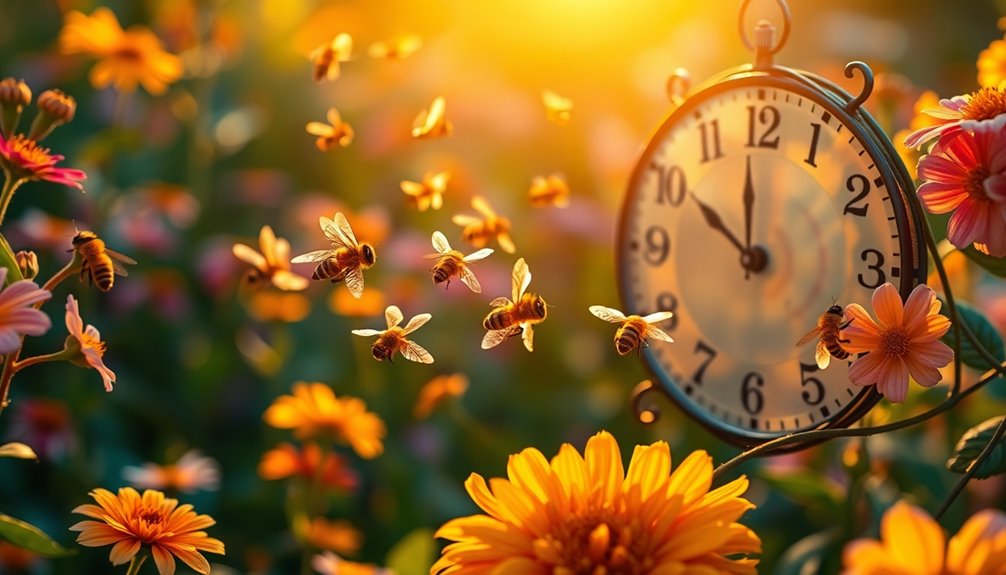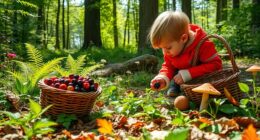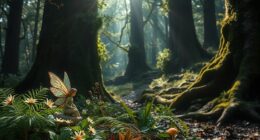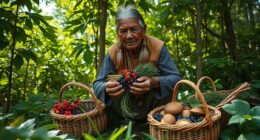Foraging food means gathering wild, edible plants and fungi from nature. It's an ancient practice that offers a sustainable and cost-free way to eat nutritious ingredients. You'll find everything from dandelions to wild garlic in local parks, forests, and even urban areas. However, it's vital to know what's safe to eat; misidentification can be dangerous. Learning how to identify toxic lookalikes and practicing ethical harvesting is essential. Plus, by foraging, you connect with nature and your community. Stick around, and you'll discover more about the best foraging locations and the delicious wild food waiting for you!
Key Takeaways
- Foraging involves gathering wild, edible plants and fungi, allowing individuals to access free, nutritious food from nature.
- It connects people to their local ecosystem while promoting sustainable living and healthier eating habits.
- Knowledge of plant identification is crucial to avoid toxic species and ensure safe consumption.
- Foraging can help supplement diets, especially in food deserts, providing fresh produce where options are limited.
- Participating in community foraging initiatives fosters social connections and preserves ancestral traditions related to food gathering.
Understanding Foraging
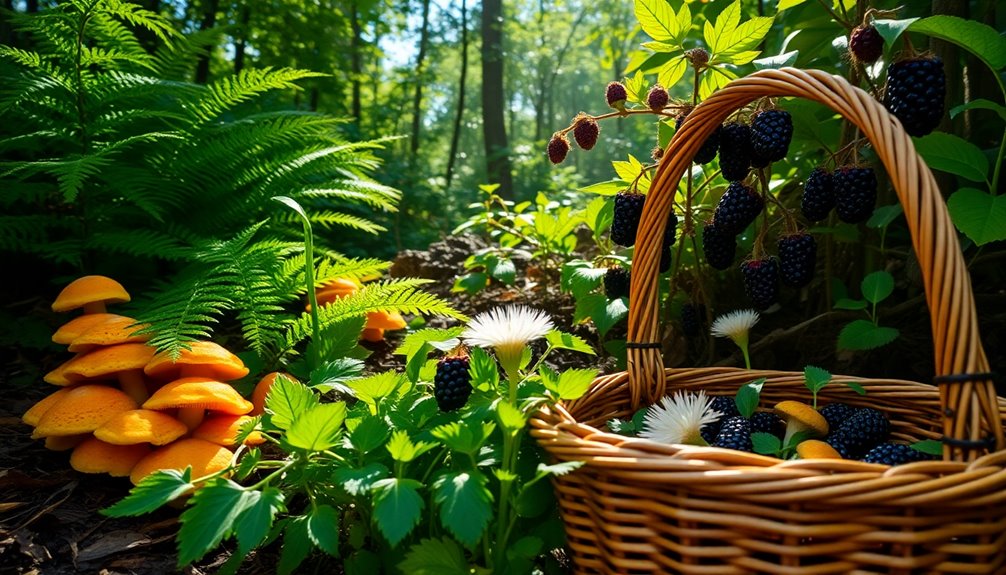
Understanding foraging is fundamental if you want to connect with nature while gathering nutritious wild foods. Foraging is the practice of collecting wild food resources, a skill that's been essential for humans for thousands of years. By learning about edible plants and fungi, you tap into local ecosystems and promote sustainable practices. These wild foods often pack a higher nutrient density than cultivated crops, making them a valuable addition to your diet.
Recently, more people have shown interest in foraging, driven by a desire for sustainable living and health-conscious eating. However, it's imperative to identify edible plants accurately; misidentification can lead to health risks. To stay safe, utilize field guides or foraging apps that help you recognize what's safe and what's not. Understanding the relationships between tree species and mushrooms can significantly enhance your foraging success.
You can forage in various environments, including urban areas, but you need to stay aware of local regulations and seasonal availability. Understanding the landscape around you not only enhances your foraging experience but also deepens your connection to nature.
Top Edible Plants to Forage
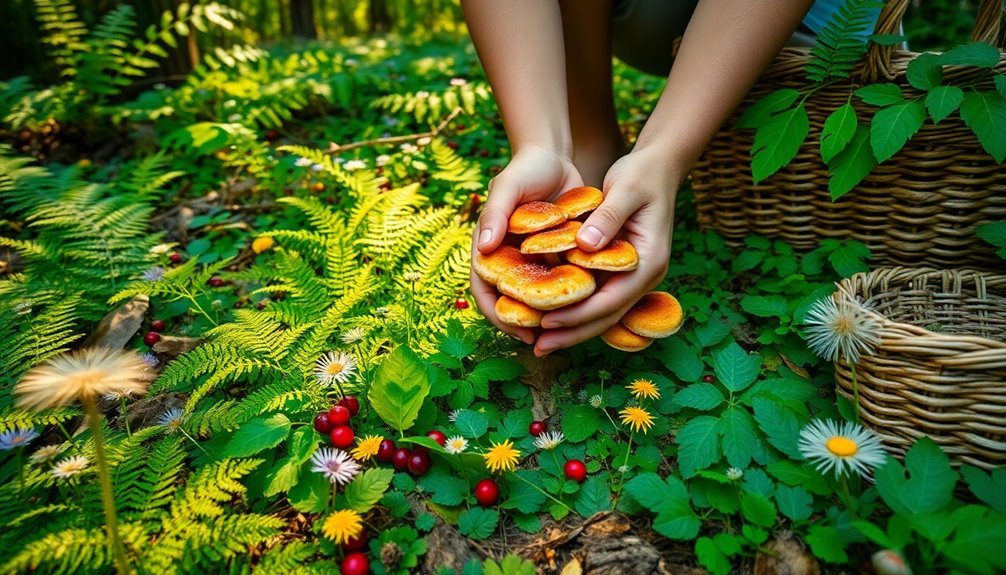
Foraging for edible plants can be an exciting adventure that connects you directly to nature's bounty. Discovering wild foods in your surroundings not only enriches your meals but also deepens your appreciation for the environment. Many regions, like Minnesota(the importance of sustainable harvesting), offer a variety of wild edibles that enhance the foraging experience. Utilizing eco-friendly practices while foraging can further ensure that the natural habitats remain intact for future generations. Additionally, understanding bee foraging range can help inform you about the best times to forage based on local pollinator activity. Essential oils for hair growth can be a natural complement to this lifestyle, promoting overall wellness while you embrace the outdoors.
Here are some top edible wild plants to examine:
- Nettles: Harvest young tops in early spring. Rich in vitamins A and C, they need cooking to remove their sting, perfect for soups or gnudi.
- Wild Garlic: Found in damp areas, its leaves have a strong garlic scent. Gather them from late March to enhance dishes like crusted salmon and soups.
- Elderflowers: Blooming from late May to early July, these are great for making cordials and jams. Don't forget about elderberries in the fall for added culinary options.
- Blackberries: Abundant in autumn, these berries are high in fiber and vitamin C. They're easy to identify and can be frozen for winter use in pies or frozen yogurt.
Foraging these edible wild plants not only provides unique flavors but also connects you to the seasonal rhythms of nature. Additionally, understanding the importance of safety guidelines for urban foraging ensures that your foraging experience remains enjoyable and healthy.
Happy foraging!
Safe Foraging Practices
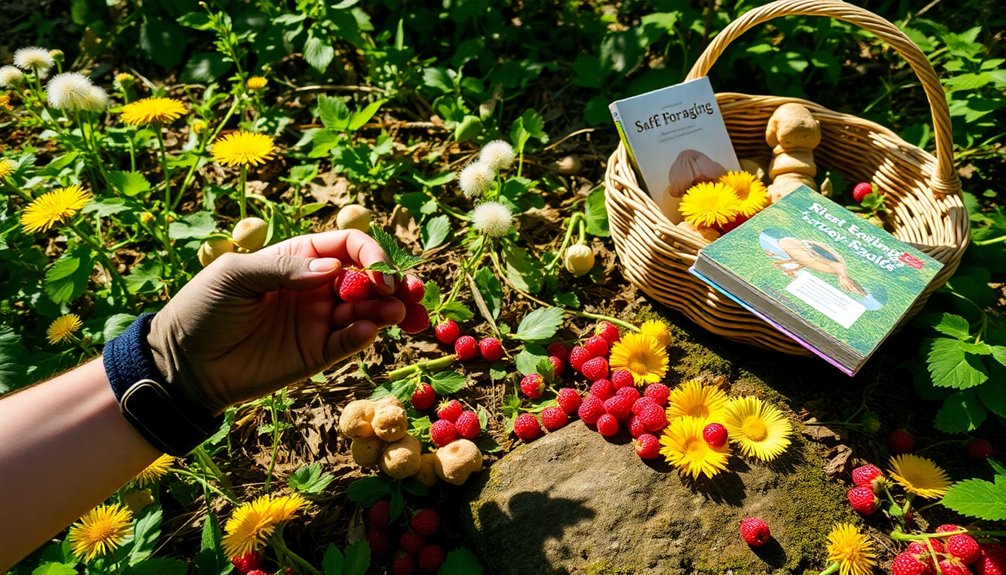
When you're out foraging, knowing how to identify plants correctly is essential for your safety.
You'll want to follow ethical guidelines while also being aware of potential contamination in the areas you explore.
Let's go over some key practices to guarantee your foraging experience is both safe and responsible.
Identification Techniques for Safety
A successful forager knows that proper identification techniques are essential for safe practices in the wild. To enjoy your foraging experience while avoiding toxic reactions, follow these guidelines:
- Consult an expert: Always confirm the edibility of wild plants with someone knowledgeable before consumption.
- Use resources: Utilize field guides and mobile apps to assist in identifying edible plants and fungi. Multiple sources for verification are vital.
- Start small: Begin by sampling small quantities of any newly identified wild food to check for potential allergic reactions or sensitivities.
- Know your lookalikes: Familiarize yourself with toxic plants that resemble edible ones, like wild chervil and poisonous hemlock, to prevent misidentification.
Pay close attention to the plant's characteristics, such as smell, texture, and sap color. These details can provide important clues about whether a plant is safe to eat.
Ethical Harvesting Guidelines
Understanding proper identification techniques sets a solid foundation for ethical harvesting practices in foraging. You need to verify you can accurately identify wild plants before consuming them, as many edible species have toxic lookalikes.
Utilize field guides or seek advice from experienced foragers to build your knowledge.
Practice sustainable harvesting by only taking what you need. This approach allows you to enjoy free food while leaving enough for wildlife and future growth, which keeps the ecosystem healthy.
It's crucial to familiarize yourself with local regulations regarding foraging; this guarantees you're foraging legally and ethically, respecting both private property and conservation areas.
When you're foraging, avoid polluted areas like busy roads or dog walking zones to minimize contamination risks.
Start with small quantities of newly foraged foods, especially if you're trying them for the first time. This way, you can test for any adverse reactions and verify your foraging experience remains safe and enjoyable.
Contamination Awareness and Precautions
Foragers must be vigilant about potential contamination when gathering wild foods. Ensuring hygiene and safety is essential to enjoying your wild harvest without health risks. Here are some key precautions to take into account:
- Avoid foraging near busy roads or industrial sites to minimize exposure to pollutants and heavy metals.
- Stay clear of areas frequented by dogs, as animal waste can introduce harmful bacteria.
- Always wash your foraged items thoroughly to remove dirt, insects, and any potential contaminants.
- Use clean tools and gloves while handling wild foods to prevent the transfer of pathogens.
Additionally, be mindful of local regulations regarding foraging in public spaces. This not only protects the environment from overharvesting but also helps minimize contamination risks.
Identifying What to Avoid
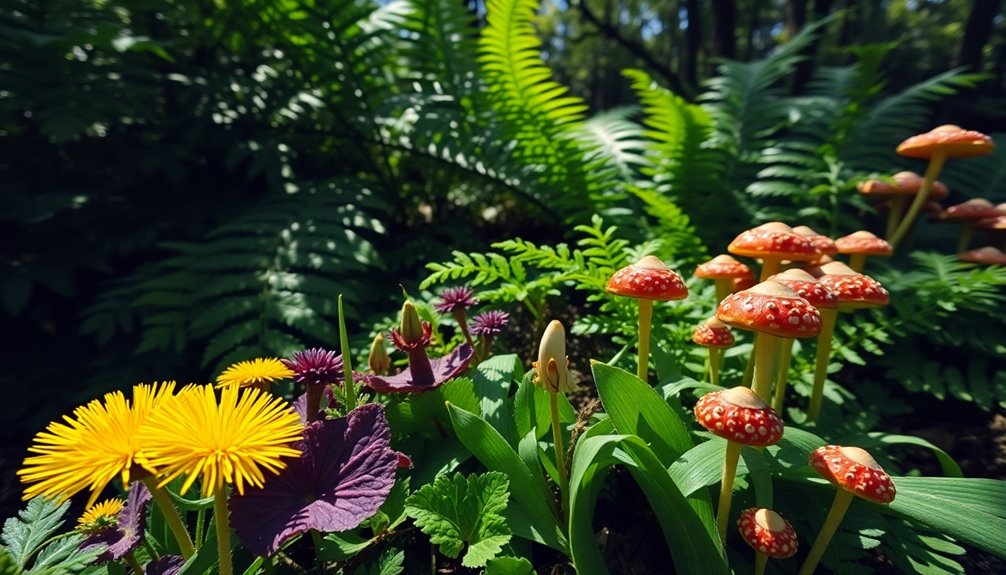
When exploring the world of wild foraging, knowing what to avoid is just as important as identifying safe, edible plants. Misidentifying wild greens can lead to dangerous consequences, as some edible plants closely resemble toxic ones. For instance, wild chervil looks like hemlock, which can be fatal if consumed. Always consult reliable resources and enhance your botanical knowledge to evade such risks.
Here's a quick reference table to help you identify what to steer clear of while foraging:
| What to Avoid | Why |
|---|---|
| Wild chervil | Resembles deadly hemlock |
| Contaminated areas | Risk of harmful substances |
| Unfamiliar wild greens | Potential for allergic reactions |
| Overharvesting | Disrupts local ecosystems; leave plenty |
Before trying a new wild food, start with small amounts to test for any adverse reactions. Remember, when foraging, practice caution, and always leave plenty of plants behind to guarantee sustainability and support local wildlife habitats. Staying informed and cautious will make your foraging adventures both safe and rewarding!
Ideal Foraging Locations
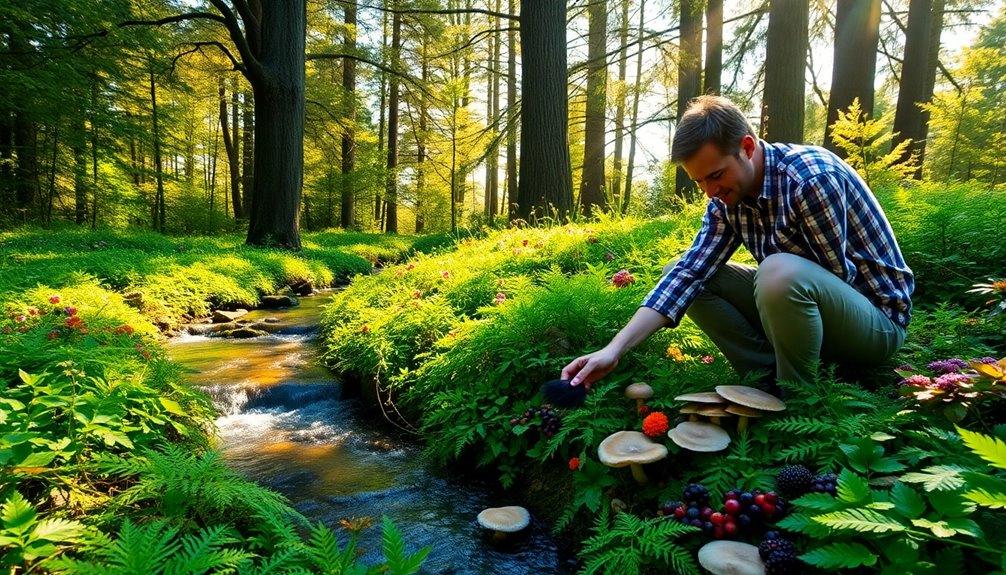
Finding the right spot for foraging can make all the difference in your experience and success. To maximize your chances of finding abundant food sources, consider these ideal foraging locations:
- Public parks: These often host a variety of edible plants and fruits.
- Nature reserves: Protected areas usually have thriving ecosystems rich in wild foods.
- Natural areas: Look for forests, meadows, or wetlands where diverse plant life flourishes.
- Seasonal hotspots: Pay attention to timing; for example, elderflowers bloom in late spring, while blackberries ripen in autumn.
Always seek permission before foraging on private land and respect local regulations, which can vary by region.
It's important to avoid areas that might be contaminated, such as those near busy roads or where pets frequent.
By choosing the right locations and considering seasonal availability, you'll enhance your foraging experience.
Remember, the goal is to gather food sources while minimizing your ecological impact—leave enough behind for wildlife and future growth.
Enjoy the adventure and the bounty that nature has to offer!
Foraging in Urban Areas
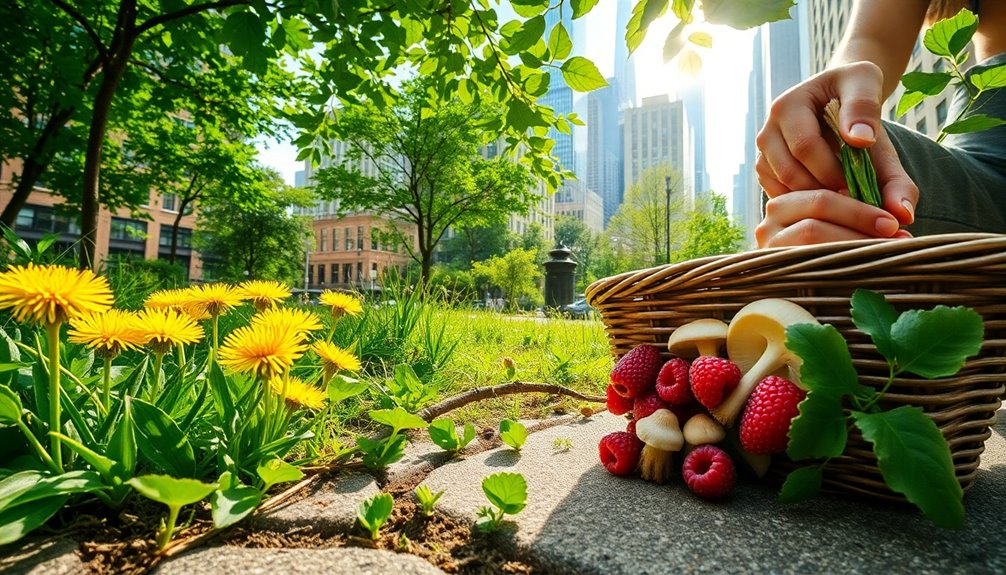
In urban areas, you might be surprised to find a wealth of edible plants like dandelions and elderflowers right in your neighborhood.
By engaging in community foraging initiatives, you can connect with neighbors and share the bounty while being mindful of local foraging laws.
It's a great way to explore your environment, reduce waste, and enjoy fresh, free food.
Urban Edible Plants
Foraging in urban areas opens up a world of culinary possibilities right at your doorstep. You might be surprised to discover how many wild edible plants thrive in your neighborhood. By exploring parks, gardens, and sidewalks, you can find nutrient-dense options that are both delicious and cost-effective. Consider incorporating these urban edibles into your meals:
- Wild Garlic: Great for adding a garlicky kick to salads and pestos.
- Stinging Nettles: Packed with vitamins, they can be used in soups or as a spinach substitute.
- Dandelions: Both the leaves and flowers are edible, perfect for salads or teas.
- Elderflowers: Ideal for making homemade syrups or infusions.
Before you start foraging, remember to check local regulations regarding harvesting in public spaces versus private property. Additionally, consider creating a small indoor garden with self-watering planters to cultivate your own herbs alongside foraging. Nutritional balance is crucial when incorporating foraged foods into your diet, as it helps ensure you are receiving a variety of essential nutrients. Incorporating herbs such as turmeric can also enhance your meals while providing health benefits. Regularly using herbs can reduce cortisol levels, contributing to overall well-being.
It's essential to be mindful of where you gather your food. Engaging with local foraging groups and workshops can deepen your knowledge of urban edible plants, helping you feel more connected to your environment.
Community Foraging Initiatives
Many urban communities are embracing foraging initiatives that not only educate residents about wild edibles but also foster a sense of connection to their local environment. These initiatives often focus on identifying and harvesting wild food plants like dandelions and wild garlic, which thrive in parks and green spaces.
By participating in local foraging groups or workshops, you can engage with your ecosystem and build community ties while learning sustainable practices.
During urban foraging events, you'll discover the seasonal availability of wild foods and the importance of ethical foraging. This means respecting nature by leaving enough for wildlife and being mindful of local regulations.
These initiatives also highlight food deserts, showing you how foraging can supplement your diet with readily available wild edibles.
Moreover, foraging connects you to historical practices of gathering food, encouraging a deeper appreciation for the natural resources in your neighborhood.
By joining these community efforts, you're not just accessing free food; you're also participating in a movement that values sustainability and enhances your relationship with nature.
Legal Considerations for Foraging
Understanding the legal landscape around foraging in urban areas is essential for any budding forager. While foraging on public land is generally permitted, you must get explicit permission before foraging on private property. Local regulations can vary greatly, so always check your city or state laws regarding foraging to avoid any legal issues.
Here are some key legal considerations you should keep in mind:
- Public Land: Foraging is typically allowed in parks and other public spaces.
- Private Property: Always seek permission from landowners before foraging.
- Local Regulations: Research specific city or state rules as they can differ widely.
- Sustainable Practices: Respect local ecosystems by leaving enough food for wildlife.
Engaging with your community can foster sustainable foraging practices and help raise awareness about local edible plants.
Always consider the impact of your harvesting methods, ensuring you're not depleting resources.
By understanding these legal considerations, you can enjoy the benefits of foraging while respecting both the law and the environment.
Happy foraging!
Cultural Significance of Foraging
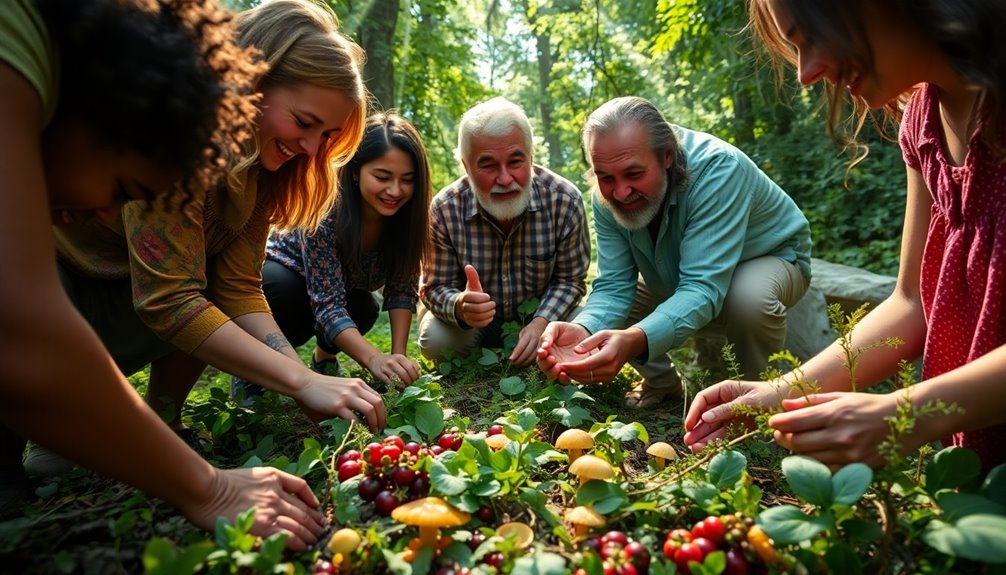
The practice of foraging carries deep cultural significance, especially among marginalized communities where it serves as an essential link to heritage and identity. For many, foraging isn't just about gathering food and medicine; it's a way to reconnect with ancestral traditions and preserve unique cultural practices.
You'll find that these activities often involve sharing knowledge, where wisdom about edible plants is passed down, particularly through women who've historically been the custodians of this crucial information.
Moreover, foraging fosters community connections. When you join others in searching for wild edibles, you strengthen bonds and promote a spirit of generosity, as participants share their finds and experiences. This communal aspect not only enriches personal relationships but also reinforces the importance of sustainability and ecological awareness.
As interest in foraging resurges, it reflects a broader cultural movement toward self-sufficiency and a deeper understanding of our natural surroundings. By stepping into this practice, you're not just gathering free food; you're also engaging with a rich tapestry of cultural history that emphasizes community, ecology, and identity. Additionally, foraging can encourage the importance of sustainable practices, as it aligns with principles that promote ecological awareness and resource conservation.
Frequently Asked Questions
What Is the Meaning of Foraging Food?
Foraging food means actively searching for and gathering wild edible plants, fruits, and fungi from nature.
It's a practice that connects you to the environment and helps you appreciate where food comes from. You'll discover a variety of nutritious options often overlooked in stores.
While foraging, remember to respect local regulations and seek permission if you're on private land.
This rewarding activity not only nourishes you but also fosters a deeper connection with nature.
What Is the Golden Rule of Foraging?
When you're diving into foraging, remember that the golden rule is to identify your wild food correctly. You wouldn't want to confuse it with something toxic, right?
Start small when tasting new finds to check for allergies, and avoid eating anything during the first week of identification.
Familiarize yourself with toxic lookalikes, and don't hesitate to consult field guides or seasoned foragers to sharpen your skills and stay safe.
What Not to Eat When Foraging?
When foraging, you should avoid plants that resemble toxic species, like wild chervil and hemlock.
Always steer clear of any wild foods showing signs of contamination, especially near roads or polluted areas.
If a plant has white sap, it's best to skip it, as it often indicates toxicity.
Finally, educate yourself on preparation methods; some plants, like pokeweed, require specific cooking processes to remove harmful compounds before they're safe to eat.
What Is the Rule of Foraging?
The rule of foraging is simple yet essential: identify, respect, and preserve.
You must accurately identify edible plants, or you risk serious health issues. When you're unsure, don't consume it.
Respect the environment by leaving some plants for wildlife, and preserve local regulations.
Start with small amounts to monitor your body's reaction.
Conclusion
Foraging opens up a world of free food right at your fingertips. By learning to identify edible plants and practicing safe foraging habits, you can enjoy nature's bounty while saving money. Remember, one person's treasure can be another's trash, so steer clear of toxic plants. Whether you're in the woods or your local park, this ancient practice connects you with nature and adds a fresh twist to your meals. So get out there and start foraging!

